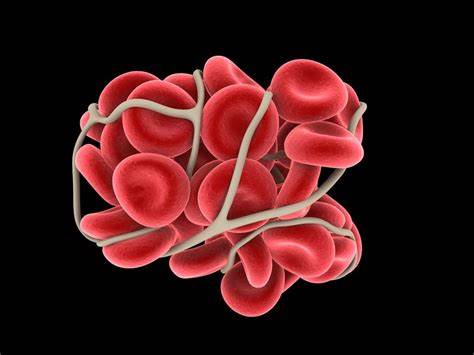Humans have been traveling to space for almost sixty years now, so, you know, we've seen some stuff.
大概60年前,人类就开始在太空旅行了,所以,我们也观察到了一些东西。
But every once in a while, NASA still runs up against something totally new and even scary.
不过,每隔那么一阵儿,美国宇航局(NASA)就会遇到全新又可怕的事情。
One such incident was published last week in the New England Journal of Medicine.
有一个这样的巧合就在上周发布在《新英格兰医学期刊》了。
The article describes the time scientists discovered a dangerous blood clot in an astronaut on board the International Space Station…
这篇文章指出,科学家发现国际空间站的一名宇航员体内有一个危险的血块。
and then treated it from Earth...to space!
而且他们认为这个血块是从地球去往宇宙的!
To protect the astronaut's privacy, the paper doesn't mention who it was or even when this happened.
为了保护这位宇航员的隐私,这篇文章并未提及这位宇航员是谁,也没提到这事儿发生的时间。
All we know is that it was two months into a six-month mission.
我们知道的唯一信息就是:这次任务由2个月变成了6个月。
Blood clots most often form in the legs of people who have been sitting for a long time, like on a plane.
血块通常是在久坐的人体腿部形成,就像在飞机上的那种久坐。
But this one was found in the astronaut's jugular vein, which connects the heart to the brain.
但这个血块却是在这名宇航员的颈静脉发现的,而颈静脉是连接心脏和大脑的。
Which is...pretty important stuff.
所以颈静脉非常重要。
The biggest risk with a clot is that it breaks free, travels through the bloodstream, and ends up in the lungs.
最大的风险是:这个血块冲破束缚,通过血液流动到肺部。
There it can block blood flow to the lungs, a condition called pulmonary embolism.
如果抵达肺部,那么这个血块会阻塞血液流动到肺部,这种情况叫做肺栓塞。
About a third of people with untreated pulmonary embolism die.
肺栓塞如果不做治疗,大概会有1/3的人因此死亡。
Amazingly, this particular clot was discovered totally by accident.
让人惊讶的是:这个特殊的血块完全是偶然发现的。
Astronauts on board the ISS were taking ultrasounds of their own necks as part of an unrelated study on how the body's fluids flow in microgravity.
国际空间站上的宇航员将他们颈部超声波作为一项不相关研究的部分内容,该研究的内容是体液在微重力状态下的流动情况。
Someone happened to look at the picture and make an extremely lucky diagnosis.
有个人恰好在观察图像并且有了非常幸运的诊断。
Then, doctors were able to treat the astronaut from the ground.
然后,医生们就能在地面上治疗这位宇航员。
The normal treatment for a clot like this is blood thinners, and fortunately the ISS happened to have a small supply on board.
类似这样的血块,正常情况下是用血液稀释剂治疗的。幸运的是:国际空间站恰好有少量的血液稀释剂。
After consulting with an expert from the University of North Carolina, NASA doctors rationed the medicine for around six weeks before more could go up on the next resupply mission.
在跟北卡罗来纳大学的一位专家沟通过后,NASA的一些医生定量配给了大概6周的药物,然后就能迎来下一次的再补给任务了。
In the end, everything turned out fine, but NASA plans to study how clots might affect astronauts in the future.
最后,一切都很好,不过,NASA计划研究血块未来可能如何影响宇航员。
And what if this had happened somewhere other than on the ISS?
如果这件事不是发生在国际空间站上的话,会怎样呢?
Like, say, during a years-long Mars mission?
比如, 如果是发生在需要历时数年的火星任务中会怎样呢?
Events like this one highlight how difficult it will be to keep the crew safe and healthy on long space flights.
这样的事件表明:要在长途太空旅行中保证宇航员安全和健康是很困难的。
There's just no way to stock months and months of every possible medication, and with no quick resupplies from Earth, it'll be important to figure out what's likely to go wrong.
因为完全没办法储存可能需要的药物长达数个月的时间。而且也没法从地球快速获得再补给。所以很重要的一点是:搞清楚哪里可能出错了。
For now, let's switch gears to something much, much farther from home.
现在,咱们先将目光聚焦到离地球更远地方的事情吧:
Last week, scientists writing in the journal Nature described what might be the discovery of some of the very first stars.
上周,科学家在《自然》杂志上写道可能发现头几颗恒星的事儿。
Astronomers have wondered for a long time about when and how the earliest stars formed.
天文学家在很长的时间里一直都很好奇恒星是在何时以怎样的方式形成的。
We know today that the universe is about 13.8 billion years old, and we also know that it looked pretty different when things first got started.
今天的我们都知道宇宙已经有138亿年的历史的,而且我们也知道现在的宇宙跟刚形成的宇宙样子很不相同。
For the first few hundred millions of years, the universe was in what astronomers call the cosmic dark ages.
在形成后的头几百万年里,宇宙处于天文学家口中的黑暗时代。
At that point, there were basically only three kinds of stuff: dark matter, hydrogen atoms, and helium atoms.
那时候,基本上只有3种物质:暗物质、氢原子、氦原子。
Over time, those ingredients clumped together to form the first stars and the earliest galaxies.
随着时间的流逝,这3种成分聚集在一起,形成了第一批恒星和最早的一些星系。
Then, little by little, the universe started to look like the place we know and love today.
随后,随着时间的推移,宇宙开始变成了我们知道并喜欢的样子,也就是今天的样子。
But one of the big goals in cosmology is to understand the time around when stars first came about.
不过,宇宙学的一个重要目标是了解恒星一开始出现的时间。
And the astronomers in the Nature study had a unique chance to do that.
《自然》杂志上的这几位天文学家有一个独特的机会来做这件事。
In a previous study, they'd used Europe's XMM Newton radio telescope, which is in orbit around Earth, to zoom in on one of the farthest-known galaxy clusters.
在之前的研究中,他们使用了欧洲的XMM-牛顿射线望远镜。该望远镜在地球附近的轨道上。它可以拉近景观测距离最远的星系团。
Because of the amount of time its light has taken to reach us, we're seeing the cluster as it looked around 10.4 billion years ago.
由于其发出的光到达地球需要一定的时间,所以我们看到的星系团是104亿年前的星系团。
At this distance, the galaxies don't look like much more than a bunch of blurry smudges, but that's okay, because what the team was really interested in was their color.
在这个距离下,这些星系跟模糊的污点差不多,但这也没问题,因为该研究团队感兴趣的是这些星系的颜色。
Galaxies take on the color of all their individual stars, which go from relatively blue to redder as they age.
星系显示的颜色跟里面的每一颗恒星有关,从相对的蓝色到红一些的颜色,不一而足,这也跟恒星的年龄有关。
And using computer models, astronomers can estimate the age of a star based on its color.
通过使用计算机模型,天文学家可以根据恒星的颜色来估测恒星的年龄。
In this case, the team used NASA's Hubble Space Telescope to peer inside and study the cluster's individual galaxies.
该团队使用了NASA的哈勃望远镜窥探并研究星系团内部的各个星系。
And they found that the stars in the cluster all seemed to be around three billion years old.
他们发现,星系团中的恒星似乎都300万年左右的年龄。
Once they added the stars' age to the 10.4 billion years they were looking back in time, the team estimated that these stars formed just 370 million years after the Big Bang.
等他们把恒星的年龄增加到104亿年的时候,他们开始回溯时间并估测这些恒星是在宇宙大爆炸之后的3.7亿年后就形成了。
That would place them right at the tail-end of the cosmic dark ages, making them some of the first stars to ever exist in the universe.
这样就会把它们放在宇宙黑暗时代的尾端,所以,它们成为了宇宙里最早存在的一些恒星。
And that makes them prime targets for future observation.
因此,它们也就成了未来观测的主要目标。
Now, dating by color is a pretty imprecise technique, but even so, these first hints at the universe's oldest stars have already started to raise new questions.
现在,通过颜色来判断时间是非常不准确的技术,但即便如此,宇宙最古老恒星首次出现的这些提示已经开始引发了一些新问题。

For one, the researchers cataloged at least 19 galaxies that seem to have almost exactly that same age.
科学家们记录了至少19个星系,这19个星系似乎都年龄相仿。
Astronomers wonder if they all responded to some sudden change in cosmic conditions, or if the formation of one galaxy could have triggered some kind of chain reaction across a huge region of space.
天文学家好奇这些星系是否会响应宇宙条件下的一些突然变化,或者某个星系的形成是否会引发宇宙空间里的某种连锁反应。
Either way, we're going to need more and better observations to sort it all out.
无论是哪一种,我们都需要更多更精确的观察才能弄清楚。
And once NASA's upcoming James Webb Space Telescope launches, we'll be able to get a better look at these distant regions of the universe.
等NASA即将到来的詹姆斯·韦伯太空望远镜发射后,我们就能更好地了解遥远的区域了。
In the meantime, though, we've got blood clots to study!
不过,与此同时,我们也有血块可以研究!











